Roman Architecture › Xerxes I › Cuneiform » Origins and History
Articles and Definitions › Contents
- Roman Architecture › Origins
- Xerxes I › Who Was
- Cuneiform › Origins
Ancient civilizations › Historical places, and their characters
Roman Architecture › Origins
Definition and Origins

Roman architecture continued the legacy left by the earlier architects of the Greek world, and the Roman respect for this tradition and their particular reverence for the established architectural orders, especially the Corinthian, is evident in many of their large public buildings. However, the Romans were also great innovators and they quickly adopted new construction techniques, used new materials, and uniquely combined existing techniques with creative design to produce a whole range of new architectural structures such as the basilica, triumphal arch, monumental aqueduct, amphitheatre, granary building, and residential housing block. Many of these innovations were a response to the changing practical needs of Roman society, and these projects were all backed by a state apparatus which funded, organised, and spread them around the Roman world, guaranteeing their permanence so that many of these great edifices survive to the present day.
THE ARCHITECTURAL ORDERS
Roman architects continued to follow the guidelines established by the classical orders the Greeks had first shaped: Doric, Ionic, and Corinthian. The Corinthian was particularly favoured and many Roman buildings, even into Late Antiquity, would have a particularly Greek look to them. The Romans did, however, add their own ideas and their version of the Corinthian capital became much more decorative, as did the cornice - see, for example, the Arch of Septimius Severus in Rome (203 CE). The Romans also created the composite capital which mixed the volute of the Ionic order with the acanthus leaves of the Corinthian. The Tuscan column was another adaptation of a traditional idea which was a form of Doric column but with a smaller capital, more slender shaft without flutes, and a moulded base. The Tuscan column (as it came to be known in the Renaissance period) was especially used in domestic architecture such as peristyles and verandahs. The Romans also favoured monolithic columns rather than the Greek approach of using several drums stacked on top of each other.
ALL BUILDINGS MUST BE EXECUTED IN SUCH A WAY AS TO TAKE ACCOUNT OF DURABILITY, UTILITY & BEAUTY.
In addition, columns continued to be used even when they were no longer structurally necessary. This was to give buildings a traditional and familiar look, for example the front of the Pantheon (c. 125 CE) in Rome. Columns could be detached from the building yet remain attached to the façade at the base and entablature (free-standing columns); see, for example, Hadrian ’s Library in Athens (132 CE). Finally, columns could become a part of the wall itself (engaged columns) and function as pure decoration, for example, the upper floors of the Colosseum exterior (last quarter 1st century CE).
Greek influence is also evidenced in the fact that late Republican innovation, such as the basilica and bath buildings, usually occurred first in the south of Italy in Campania (see especially Pompeii ) which was closer to the long-established Greek colonies of Magna Graecia. It was from here that we have the oldest surviving dome building, the frigidarium (cold room) of the Stabian Baths at Pompeii (2nd century BCE). As with many other areas, the Romans took an idea and pushed it to its maximum possibility, and the huge imperial bath complexes incorporated soaring arches, arches springing directly from column capitals, and domes which spanned seemingly impossible distances.

Architectural Column Orders
The Augustan period saw a surge in building activity, innovation in design, and extravagant use of marble, symptoms of a Rome that was beginning to flex its muscles and with an increased confidence break away from the rigid tradition of earlier civilizations. This was also the time when increased imperial patronage allowed for ever bigger and more impressive building projects to be undertaken, not only in Rome itself but across the Empire, where buildings became propaganda for the might and perceived cultural superiority of the Roman world.
As the Empire expanded, ideas and even craftsmen became integrated into the Roman architectural industry, often following their familiar materials like marble to the sites of construction. The evidence of eastern influence can be seen in such features as papyrus leaves in capitals, sculptured pedestals, street colonnades, and the nymphaeum (ornamental fountain).
MATERIALS & TECHNIQUES
The first all-marble building was the Temple of Jupiter Stator in Rome (146 BCE), but it was not until the Empire that the use of marble became more widespread and the stone of choice for the most impressive state-funded building projects. The most commonly used from Italy was Carrara (Luna) marble from Tuscany (see, for example, the 30 BCE Temple of Apollo on the Palatine). Marble was also readily available from across the empire; especially esteemed were the Parian marble of Paros in the Cyclades and Pentelic from Athens. Coloured varieties were also much favoured by Roman architects, for example, yellow Numidian marble from North Africa, purple Phyrgian from central Turkey, red porphyry from Egypt, and green-veined Carystian marble from Euboea. Foreign marble was, though, mainly reserved for use in columns and, due to the costs of transportation, imperial projects.
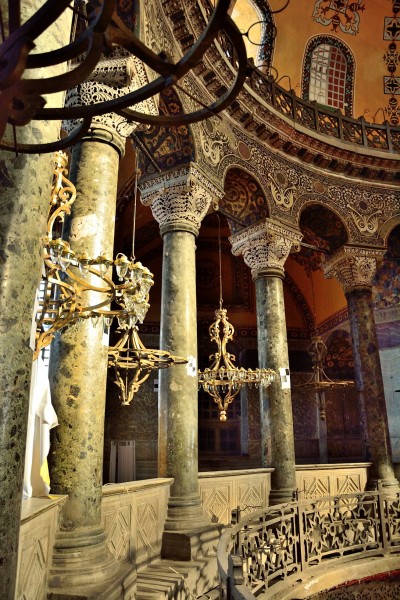
Columns of Hagia Sophia
Besides marble, travertine white limestone was also made available from quarries near Tivoli, and its favourability towards precise carving and inherent load-bearing strength made it a favourite substitute for marble amongst Roman architects from the 1st century BCE. It was especially used for paving, door and window frames, and steps.
The Romans did not invent lime mortar but they were the first to see the full possibilities of using it to produce concrete.Concrete rubble had usually been reserved for use as a filler material but Roman architects realised that the material could support great weight and could, therefore, with a little imagination, be used to help span space and create a whole new set of building opportunities. They called this material opus caementicium from the stone aggregate ( caementa ) which was mixed with the lime mortar. The material had a thick consistency when prepared and so was laid not poured like modern concrete.The first documented evidence of its use is from 3rd century BCE Cosa and its first use in Rome seems to have been a 2nd century BCE warehouse. Also in the 2nd century BCE it was discovered that by using pozzolana (concrete made using volcanic sand, pulvis puteolanus ), which had a high silica content, the concrete could set under water and was even stronger than normal concrete. By the 1st century BCE its use seems widespread in foundations, walls, and vaults. Perhaps the best example of its possibilities in construction is the Sanctuary of Fortuna Primigenia at Palestrina.
IN ADDITION TO THE STRUCTURAL POSSIBILITIES OFFERED BY CONCRETE, THE MATERIAL WAS ALSO A LOT CHEAPER THAN SOLID STONE.
In addition to the structural possibilities offered by concrete, the material was also a lot cheaper than solid stone and could be given a more presentable façade using stucco, marble veneer, or another relatively cheap material: fired brick or terracotta.Sun-dried mud bricks had been used for centuries and continued to be used for more modest projects up to the 1st century CE, but fired bricks had the advantage of durability and could be carved just like stone to resemble such standard architectural features as capitals and dentils.
Bricks were typically 59 cm square and 2.5-5 cm thick. Uncut they were used in roofing and drains, but for other uses they were usually cut into 18 triangles. There were also circular bricks, typically cut into quarters, which were used for columns.Bricks could also be used in domes such as that of the Temple of Asklepios Soter at Pergamon and even became a decorative feature themselves by using different coloured bricks (usually yellow and orange) and laid to create patterns.
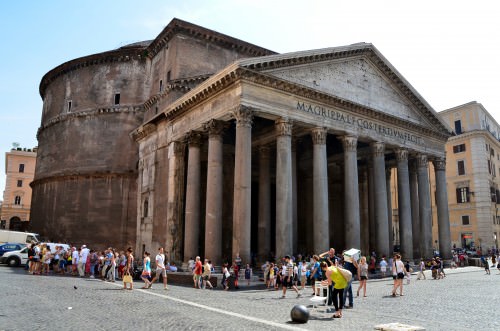
Pantheon, Rome
Stucco was used to face brick walls and could be carved, like bricks could be, to reproduce the architectural decorations previously rendered only in stone. The stucco was made from a mix of sand, gypsum, and even marble dust in the best quality material.
Volcanic tufa and pumice were used in domes because of their light weight as in, for example, the Pantheon. Basalt was often used for paving and roads, laid as polygonal blocks, and Egyptian grey and pink granite was popular for obelisks and columns.Finally, terracotta was also used for moulded ornamentation on buildings and became a common embellishment of private homes and tombs.
ROMAN ARCHITECTS
In the Roman world the credit for buildings was largely placed at the feet of the person who conceived and paid for the project rather than the architect who oversaw the realisation of it; therefore, he often remains anonymous. Those architects employed for specific projects by the emperor are better known. We know of Trajan ’s favoured architect, Apollodorus of Damascus, famed for his skills in bridge building, for example, and who was responsible for, amongst other projects, Trajan's Forum and Baths in Rome (104-9 CE). Severus and Celer were the architects responsible for the fantastic sounding revolving roof of Nero’s Golden House. In general, architects supervised whilst it was contractors ( redemptores ) who actually carried out the project based on the architect's measured drawings.
Certainly, the most famous Roman architect is Vitruvius, principally because his On Architecture, a 10-volume study of architecture, has survived intact. We do not actually know much about his own work - only a basilica he constructed in Fano and that he did work for Julius Caesar and Augustus. On Architecture covers all facets of architecture, types of building, advice for would-be architects, and much more besides. One interesting point about the work is that it reveals that the ancient architect was expected to have many skills which nowadays would be separated into different specialisations. Vitruvius also encapsulated the essential ethos of Roman architecture: 'All buildings must be executed in such a way as to take account of durability, utility and beauty.' ( On Architecture, Book I, Ch. III)

Pont del Diable Aqueduct, Tarraco
KEY ROMAN BUILDINGS
Aqueducts & Bridges - These sometimes massive structures, with single, double, or triple tiers of arches, were designed to carry fresh water to urban centres from sources sometimes many kilometres away. The earliest in Rome was the Aqua Appia (312 BCE), but the most impressive example is undoubtedly the Pont du Gard near Nimes (c. 14 CE). Roman bridges could make similar use of the arch to span rivers and ravines. Constructed with a flat wooden superstructure over stone piers or arches, examples still survive today. One of the best preserved is the granite Tagus Bridge at Alcantara (106 CE) which has arches spanning over 30 metres.
Basilicas - The basilica was adopted by the Christian church but was conceived by the Romans as a place for any large gathering, with the most common use being law courts. They were usually built along one side of the forum, the city ’s marketplace, which was enclosed on all sides by colonnades. The basilica's long hall and roof were supported by columns and piers on all sides. The columns created a central nave flanked on all sides by an aisle. A gallery ran around the first floor and later there was an apse at one or both ends. A typical example is the Severan Basilica at Lepcis Magna (216 CE).

Plan of the Baths of Diocletian
Baths - Roman baths display the typical Roman ability for creating breath-taking interior space using arches, domes, vaults, and buttresses. The largest of these often huge complexes were built symmetrically along a single axis and included pools, cold and hot rooms, fountains, libraries, under-floor heating, and sometimes inter-wall heating through terracotta piping. Their exteriors were usually plain, but within they were often sumptuous with the lavish use of columns, marble, statues and mosaics. One of the finest and certainly best surviving examples is the Baths of Caracalla in Rome (completed 216 CE).
Private Homes - Perhaps more famous for their richly decorated interior walls using fresco and stucco, Roman private residences could also enchant with atrium, peristyles, gardens and fountains, all ordered in harmonious symmetry. For a typical example, see the House of the Vettii at Pompeii (1st century BCE - 79 CE).
Even more innovative, though, were the large apartment blocks ( insula ) for the less well-off city-dwellers. These were constructed using brick, concrete, and wood, sometimes had balconies, and there were often shops on the ground floor street front. Appearing as early as the 3rd century BCE, by the 1st century BCE examples could have 12 stories, but state-imposed height restrictions resulted in buildings averaging four to five stories (at least at the front side as there were no such restrictions for the rear of the building). Some of the very few surviving examples may be seen at Ostia.

Temple of Baachus, Baalbek
Temples - The Roman temple was a combination of the Etruscan and Greek models with an inner cella at the rear of the building surrounded by columns and placed on a raised platform (up to 3.5 metres high) with a stepped entrance and columned porch, the focal point of the building (in contrast to Greek temples where all four sides could be equally important in the urban landscape). Surviving practically complete and a typical example is the Maison Carrée at Nimes (16 BCE). Temples were usually rectangular but could take other forms such as circular or polygonal, for example, the temple of Venus at Baalbeck (2nd-3rd century CE).
THE FULLY ENCLOSED AMPHITHEATRE WAS A PARTICULAR FAVOURITE OF THE ROMANS.
Theatres & Amphitheatres - The Roman theatre was of course inspired by the Greek version, but the orchestra was made semicircular and the whole made using stone. The Romans also added a highly decorative stage building ( scaenae frons ) which incorporated different levels of columns, projections, pediments, and statues such as is found in the theatre at Orange (27 BCE - 14 CE). A similar approach was taken with façades of libraries - see, for example, the Celsus Library in Ephesus(2nd century CE). Theatres also display the Roman passion for enclosing spaces, especially as they were often (partially or completely) roofed in wood or employed canvas awnings.
The fully enclosed amphitheatre was a particular favourite of the Romans. The Colosseum is the largest and most famous, and it is a typical example copied throughout the empire: a highly decorative exterior, seats set over a network of barrel vaults, and underground rooms below the arena floor to hide people, animals and props until they were needed in the spectacles.
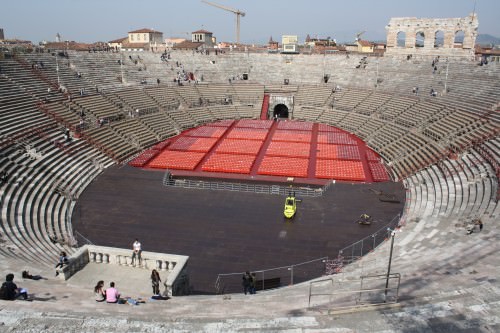
Amphitheatre of Verona
Triumphal Arches - The triumphal arch, with a single, double, or triple entrance, had no practical function other than to commemorate in sculpture and inscription significant events such as military victories. Early examples stood over thoroughfares - the earliest being the two arches set up by L.Stertinius in Rome (196 BCE) - but later examples were often protected by steps. Topped by a bronze four-horse chariot, they became imposing stone monuments to Roman vanity. The Arch of Constantine (c. 315 CE) in Rome is the largest surviving example and is perhaps the last great monument of Imperial Rome.
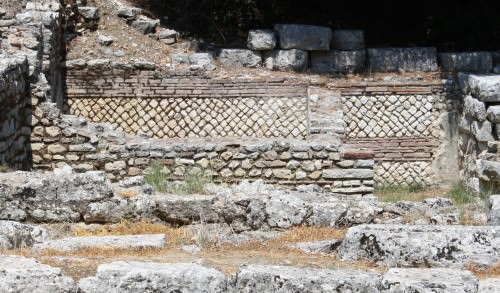
Roman Opus Mixtum Wall
- opus incertum - first appeared in the 3rd century BCE and used small irregular chunks of stone smoothed on one side.
- opus reticulatum - from the 2nd century BCE and used pyramid -shaped chunks with 6-12 cm square base and height of 8-14 cm. The stone was set with the base facing outwards and laid in diagonal arrangements.
- opus mixtum - common from the 1st century CE, this was a combination of opus reticulatum with a layer (course) of horizontal brick every fourth course and at the edges of the wall.
- opus testaceum - common from the 1st century CE and used courses of brick only.
- opus vittatum - used an alternative course of brick with two courses of tufa blocks with a rectangular side facing outwards and diminishing in size towards the inner surface. It was especially popular from the 4th century CE across the Empire.
Despite the decorative effect of these various arrangements of stone and brick, most walls were actually covered both inside and out with white plaster stucco for protection against heat and rain for the outside and to provide a smooth surface for fine decorative wall painting on the inside.
CONCLUSION
Roman architecture, then, has provided us with magnificent structures that have, quite literally, stood the test of time. By combining a wide range of materials with daring designs, the Romans were able to push the boundaries of physics and turn architecture into an art form. The result was that architecture became an imperial tool to demonstrate to the world that Rome was culturally superior because only she had the wealth, skills, and audacity to produce such edifices. Even more significantly, the Roman use of concrete, brick, and arches twinned with building designs like the amphitheatre and basilica would immeasurably influence all following western architecture right up to the present day.
Xerxes I › Who Was
Definition and Origins

Xerxes I (ruled 486-465 BCE), also known as Xerxes the Great, was the king of the Persian Achaemenid Empire. His official title was Shahanshah which, though usually translated as `emperor', actually means `king of kings'. He is identified as the Ahasuerus of Persia in the biblical Book of Esther (although his son, Artaxerxes I, is also a possibility as is Artaxerxes II) and is referenced at length in the works of Herodotus, Diodorus Siculus, Quintus Curtius Rufus, and, to a lesser extent, in Plutarch. Herodotus is the primary source for the story of his expedition to Greece. The name ` Xerxes ' is the Greekversion of the Persian `Khshayarsa' (or Khashyar Shah), and so he is known in the west as `Xerxes' but in the east as `Khshayarsa'.
His mother was Atossa, the daughter of Cyrus the Great (who founded the Achaemenid Empire ). He was, therefore, accepted as a great king before having to prove himself so in any way. Xerxes is celebrated for his many building projects throughout his empire but is best known, in both ancient and modern sources, for the massive expedition he mounted against Greece in 480 BCE which, according to Herodotus, assembled the largest and most well equipped fighting force ever put into the field up to that point. He was the son of Darius the Great (550-486 BCE) who, in an effort to punish Athens for their support of the Ionian colonies' revolt against Persian rule, had invaded Greece in 492 BCE. The Persians were defeated by the Greek forces at the Battle of Marathon in 490 BCE, and Darius died in 486 BCE before he could mount another offensive. It, therefore, fell to his son to carry out his father's wishes and, in amassing an army of such size and strength, Xerxes felt confident of his success in achieving what the great Darius had been unable to realize.
XERXES HAD TO DEAL WITH THE INSURRECTION OF BABYLON & THE REVOLTS AGAINST PERSIAN RULE IN EGYPT.
EARLY CAMPAIGNS
Xerxes was not the eldest of Darius' sons but, as the first-born of his marriage with Atossa, was chosen as successor. Upon Darius' death, Xerxes' older half-brother, Artabazenes, claimed the throne but was rebuffed because his mother was a commoner while Xerxes' mother was the daughter of the great Cyrus. He married the princess Amestris, daughter of Otanes, who would become mother to his sons Darius, Hystaspes, Artaxerxes I, Achamenes, and daughters Amytis and Rhodogune.Upon assuming the throne, Xerxes' Commander-in-Chief of the Army, Mardonius (who was also his cousin and brother-in-law), pressured him to renew the campaign against Greece. Mardonius' motives, it seems, were personal, as he hoped to rule the conquered nation as Satrap following Xerxes' victory. Xerxes' uncle and advisor, Artabanus, tried to persuade him to abandon the expedition but Mardonius' arguments prevailed. Even so, there were many matters to attend to such as the insurrection of Babylon and the revolts against Persian rule in Egypt, and Xerxes expended considerable time throughout the year 485 BCE in quelling these and restoring order.
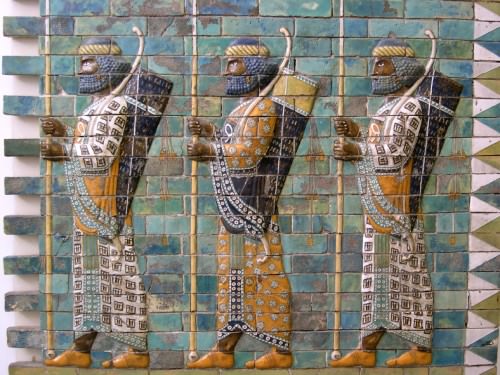
Persian Archers
Although his grandfather Cyrus had been a friend to Babylon, Xerxes had subjugated the city and melted down the golden statue of Marduk, their patron deity. This was a particular affront to the dignity and tradition of Babylon because one of the religious duties of a ruler was to grasp the hands of the statue of Marduk at the New Year's festival in order to ensure continued prosperity throughout the land; Babylon thus enjoyed a prestige among the cities of Mesopotamia as the site of this ritual. Cyrus had been diligent in officiating at the festival, as had Darius, but Xerxes considered it a matter of little consequence. He ignored the established relationships with former allies, referring to himself as the King of the Persians and the Medes, and treated all as subject to his rule. Babylon revolted against him twice before he lay siege to it and crushed the rebellion.
XERXES SPENT FOUR YEARS AMASSING ENOUGH SUPPLIES & WEAPONRY FOR HIS CAMPAIGN IN GREECE.
GREECE: THE PERSIAN WARS
With relative peace established in his empire, he again turned his attention to Greece and conquest. He spent four years amassing enough supplies and weaponry for the campaign and also conscripting as many men as he could from various regions to ensure his victory. Herodotus tells the story of Pythias the Lydian (a descendant of King Croesus ) whose five sons were among those conscripted. Pythias hosted the king and his army lavishly at Sardis in the winter of 481-480 BCE and offered to give Xerxes a considerable sum of money for the campaign, but Xerxes refused his offer and, instead, rewarded Pythias for his generosity by adding greatly to his treasury.
Prior to Xerxes' departure for the Hellespont, a bad omen in the form of an eclipse appeared in the sky but Xerxes, assured by his diviners that it meant nothing, proceeded with his plans. Pythias, however, recognized the omen as a warning of impending doom and, emboldened by Xerxes' generosity and kindness, asked if his eldest son could be released from the army so that he would have at least one son to care for him in his old age and carry on as heir. Xerxes became enraged at this request as it meant that Pythias doubted his chances of success. He had the eldest son removed from the ranks, cut him in half, placed the two sections of the corpse on either side of the road, and marched his troops away between them.
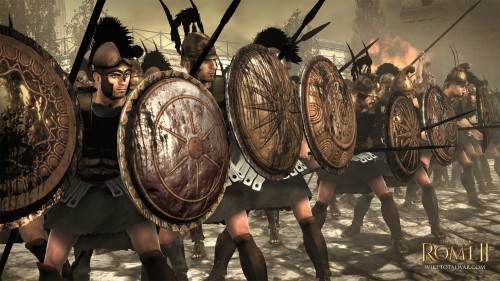
Greek Phalanx
According to Herodotus, the size of Xerxes' expeditionary force was over two million men and four thousand ships. Diodorus Siculus and Quintus Curtius Rufus confirm the enormity of Xerxes' army, though their numbers differ from Herodotus and from each other. In order to move his ships freely, he had a canal dug across the Isthmus of Actium near Mr. Athos, the remains of which are still visible in the present day. He assembled his forces to cross the Hellespont into Europe and, Herodotus reports, watched them as they stood in formation. The size of the army and its majesty
first gave Xerxes a feeling of deep self-satisfaction, but later he began to weep. When his uncle, Artabanus (the one who had at first freely expressed his opinion and advised Xerxes not to attack Greece) noticed that Xerxes was crying he said, `My lord, a short while ago you were feeling happy with your situation and now you are weeping. What a total change of mood!' `Yes,” Xerxes answered. `I was reflecting on things and it occurred to me how short the sum total of human life is, which made me feel compassion. Look at all these people – but not one of them will still be alive in a hundred years' time'(VII.45-46).
Even so, Xerxes put the thoughts of the brevity of life from his mind and ordered the crossing and the invasion of Greece.
The omens, from the start, were not favorable to Xerxes' cause. The Hellespont is said to have risen in revolt at his crossing.In order to move his massive force, Xerxes built bridges across the water. Herodotus writes:
The Phoenicians and the Egyptians who had been assigned the task set about building their bridges (the Phoenicians using white flax and the Egyptians papyrus), taking Abydus as their starting point and directing their efforts towards the headland on the opposite coast – a distance of seven stades. They had just finished bridging the straits when a violent storm erupted which completely smashed and destroyed everything. This news made Xerxes furious. He ordered his men to give the Hellespont three hundred lashes and to sink a pair of shackles into the sea. I once heard that they also dispatched men to brand the Hellespont as well. Be that as it may, he did tell the men he had thrashing the sea to revile it in terms you would never hear from a Greek. “Bitter water,” they said, this is your punishment for wronging your master when he did no wrong to you. King Xerxes will cross you, with or without your consent. People are right not to sacrifice to a muddy, brackish stream like you!” So the sea was punished at his orders and he had the supervisors of the bridging of the Hellespont beheaded. The men assigned this grotesque task carried out their orders and another team of engineers managed to bridge the Hellespont (VII.34-36).
ARTEMISIUM & THERMOPYLAE, FOUGHT MORE OR LESS CONCURRENTLY, PROVIDED THE PERSIANS WITH VICTORIES.
Once they had reached the other side, Herodotus writes, “a really extraordinary thing happened: a horse gave birth to a hare.Xerxes dismissed it as insignificant, though its meaning was transparent. It meant that, although Xerxes would walk tall and proud on his way to attack Greece, he would return to his starting-point running for his life” (VII.57). Besides the revolt of the waters of the Hellespont and the appearance of the hare, there were other omens which indicated that Xerxes' campaign would end badly, but Xerxes dismissed all of them as meaningless and proceeded on toward his goal.
The Greeks, in the meantime, had mobilized their forces under the direction of Athens and sent forces to meet the Persian expedition and defend the mainland. The battles of Artemisium and Thermopylae, fought more or less concurrently, provided the Persians with victories (either complete or strategic) which enabled them access to Greece, and they marched on Athens as soon as they were able. Xerxes was so enraged at the Athenian resistance to his wishes that he burned the city in a furious fit, which he so regretted that, later, he would reference this as his only remorse in the entire campaign.
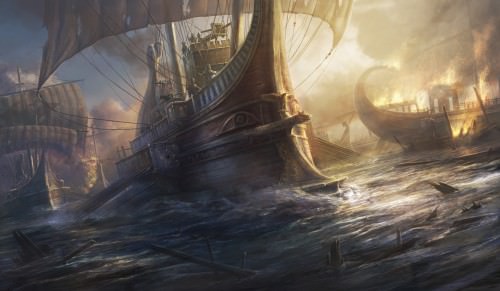
Greek Trireme
THE BATTLE OF SALAMIS
At this point, the Greeks, who had abandoned Athens and most of the countryside, had gathered their forces off the coast of the mainland at Aegina and in the Peloponnese and their navy was anchored in the straits of Salamis. Xerxes called a warcouncil to decide on his next move and whether to engage the Greeks at Salamis, return home content with the destruction of Athens, or consider other alternatives. Mardonius counseled in favor of a sea battle, as did all the other allied leaders, except for Artemisia of Caria who provided Xerxes with other options. She claimed that he need do nothing to secure victory but keep the Greeks in place until their supplies ran out and they sued for peace. While he clearly respected Artemisia and thanked her for her advice, he chose the majority opinion and committed to the naval engagement.
The Battle of Salamis, which followed, was a disaster for the Persian fleet and cost Xerxes dearly. Following the loss, he again consulted Artemisia for advice and she told him he should return home and accept Mardonius' offer to remain behind and conquer the Greeks in Xerxes' name. This time he accepted her counsel and left the country with Mardonius remaining behind to continue the war effort. Mardonius was defeated the following year at the Battle of Plataea which was fought on the same day as the equally decisive Battle of Mycale, 27 August 479 BCE.
Mardonius was killed and, with his death, the Persian forces scattered and Xerxes' ambitions for subjugating Greece were crushed. As the omen had predicted, Xerxes returned home `limping' with a fraction of his army and was forced to eat bark, weeds, and leaves because there was no food left in the regions they traveled through. The men were ravaged by disease and many died of dysentery and so, by the time Xerxes crossed back across the Hellespont and reached Sardis, he had hardly any army left to speak of.
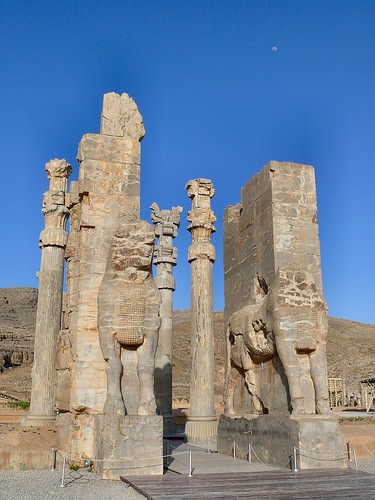
All Nations Gate at Persepolis
XERXES' BUILDING PROJECTS & DEATH
Back home, Xerxes concentrated his efforts on making larger and grander monuments and completing greater building projects than his father. In doing so, he depleted the royal treasury to an even greater extent than his expedition to Greece already had. He maintained the roadways throughout the empire, especially the Royal Road by which messages were carried (the precursor to the Roman mail system and, later, the modern-day postal system) and devoted both time and funds to expanding sites such as Susa and Persepolis. Although Darius' palace still stood, Xerxes' commissioned an even more elaborate building project to raise his own opulent palace nearby and also commanded the construction of the Hall of a Hundred Columns and the building which has been designated `The Harem' by archaeologists (because of the duplication of identical rooms in a row) which may have actually served as Xerxes' treasury. The exorbitant cost of these projects, coupled with the expense of the expedition to Greece, put a tremendous strain on Xerxes' subjects through heavy taxation. Xerxes, however, appeared not to notice a problem and continued to do as he pleased; because of this, his rule marks the beginning of the decline of the Achaemenid Empire.
ACCORDING TO HERODOTUS, XERXES' FONDNESS FOR WOMEN & LACK OF RESTRAINT LED TO HIS PURSUIT OF HIS BROTHER MASISTES' WIFE.
According to Herodotus, Xerxes' fondness for women and lack of restraint led to his pursuit of his brother Masistes' wife. When she refused him, he married one of his sons, Darius, to the daughter of Masistes, Artaynte, in hopes that, by this union, he could get closer to his brother's wife and manage to seduce her. When he saw Artaynte, however, he desired her more than the mother and, when he approached her, she agreed to an affair. Herodotus reports that, at about this same time, Xerxes' wife Amestris had woven him a beautiful shawl, which he liked so much he wore everywhere. Artaynte admired the shawl and, one day when Xerxes told her that he would give her any gift she asked for, she requested the shawl. He tried to get her to take any other gift instead because he knew that, should he give his mistress the shawl, his wife would discover the affair. He had given his word, however, and Artaynte refused any other gift, and so he gave her the shawl.
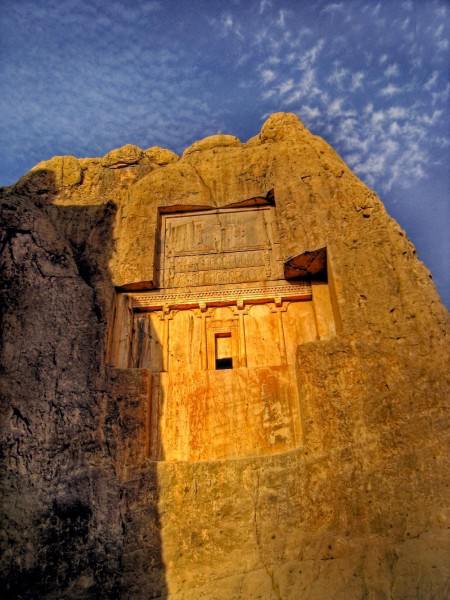
Tomb of Xerxes
As he feared, Amestris heard that Xerxes' mistress was wearing the shawl and plotted revenge. She decided to focus her energies, not on the mistress, but on Artaynte' s mother who she blamed for not raising a proper daughter (and, perhaps, because she had guessed that Artaynte was Xerxes' second choice in a mistress). At the royal banquet known as Tukta, which was held once a year and at which the king granted gifts to his subjects, Amestris asked for Masistes' wife to be delivered to her. As with Artaynte and the shawl, Xerxes pleaded with Amestris to make any other request, but she would not do so.
Xerxes then gave his brother's wife to Amestris who, according to Herodotus, “sent for Xerxes' personal guards and with their help mutilated Masistes' wife. She cut off her breasts and threw them to the dogs, cut off her nose, ears, lips, and tongue, and then sent her back home totally disfigured” (9:112). In response, Masistes tried to raise a revolt in Bactra but Xerxes, hearing of his plans, trapped him and killed him, his sons, and all of the men he had rallied to his cause. Xerxes then returned to his building projects and designs for greater, grander, monuments to commemorate his reign and distinguish him from his father. His development plans were cut short through his assassination by his minister Artabanus (a different man than his uncle of the same name) who also murdered his son Darius. Xerxes' other son, Artaxerxes I, then killed Artabanus, took the throne, and went on to complete Xerxes' grand building plans in his own name and for his own greater glory.
Cuneiform › Origins
Definition and Origins
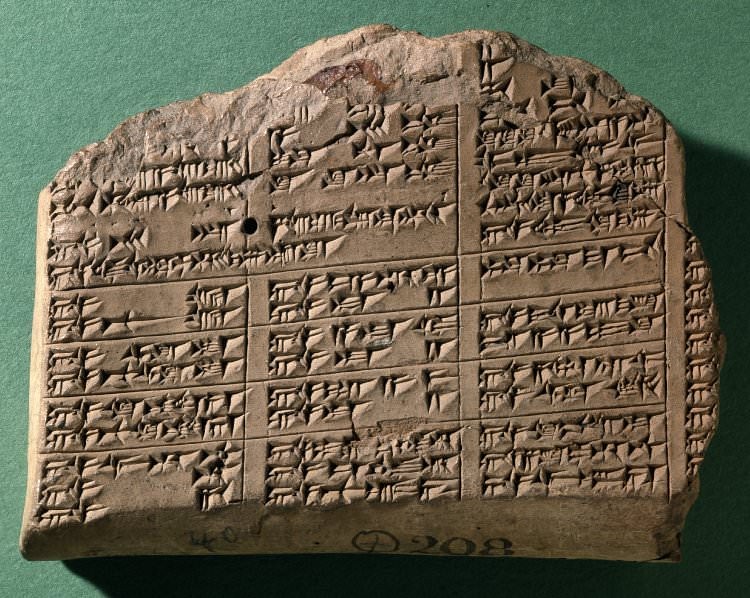
Cuneiform is a system of writing first developed by the ancient Sumerians of Mesopotamia c. 3500-3000 BCE. It is considered the most significant among the many cultural contributions of the Sumerians and the greatest among those of the Sumerian city of Uruk which advanced the writing of cuneiform c. 3200 BCE.
The name comes from the Latin word cuneus for 'wedge' owing to the wedge-shaped style of writing. In cuneiform, a carefully cut writing implement known as a stylus is pressed into soft clay to produce wedge-like impressions that represent word-signs (pictographs) and, later, phonograms or `word-concepts' (closer to a modern-day understanding of a `word'). All of the great Mesopotamian civilizations used cuneiform until it was abandoned in favour of the alphabetic script at some point after 100 BCE, including:
- Sumerians
- Akkadians
- Babylonians
- Elamites
- Hatti
- Hittites
- Assyrians
- Hurrians
When the ancient cuneiform tablets of Mesopotamia were discovered and deciphered in the late 19th century CE, they would literally transform human understanding of history. Prior to their discovery, the Bible was considered the oldest and most authoritative book in the world. The brilliant scholar and translator George Smith (1840-1876 CE) changed the understanding of history with his translation of The Epic of Gilgamesh in 1872 CE. This translation allowed other cuneiform tablets to be interpreted which overturned the traditional understanding of the biblical version of history and made room for scholarly, objective explorations of history to move forward.
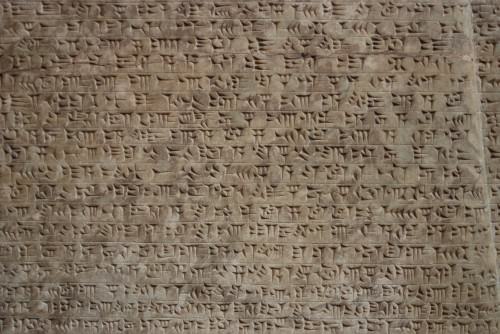
Escritura cuneiforme
EARLY CUNEIFORM
The earliest cuneiform tablets, known as proto-cuneiform, were pictorial, as the subjects they addressed were more concrete and visible (a king, a battle, a flood) but developed in complexity as the subject matter became more intangible (the will of the gods, the quest for immortality). By 3000 BCE the representations were more simplified and the strokes of the stylus conveyed word-concepts (honour) rather than word-signs (an honourable man). The written language was further refined through the rebus which isolated the phonetic value of a certain sign so as to express grammatical relationships and syntax to determine meaning. In clarifying this, the scholar Ira Spar writes:
This new way of interpreting signs is called the rebus principle. Only a few examples of its use exist in the earliest stages of cuneiform from between 3200 and 3000 BC The consistent use of this type of phonetic writing only becomes apparent after 2600 BC It constitutes the beginning of a true writing system characterized by a complex combination of word-signs and phonograms—signs for vowels and syllables—that allowed the scribe to express ideas. By the middle of the Third Millennium BC, cuneiform primarily written on clay tablets was used for a vast array of economic, religious, political, literary, and scholarly documents. (1)
LAS GRANDES OBRAS LITERARIAS DE MESOPOTAMIA, COMO LA FAMOSA ÉPICA DE GILGAMES, FUERON ESCRITAS EN CUNEIFORMES.
DEVELOPMENT OF CUNEIFORM
One no longer had to struggle with the meaning of a pictograph; one now read a word-concept which more clearly conveyed the meaning of the writer. The number of characters used in writing was also reduced from over 1,000 to 600 in order to simplify and clarify the written word. The best example of this is given by the historian Paul Kriwaczek who notes that, in the time of proto-cuneiform:
All that had been devised thus far was a technique for noting down things, items and objects, not a writing system. A record of `Two Sheep Temple God Inanna ' tells us nothing about whether the sheep are being delivered to, or received from, the temple, whether they are carcasses, beasts on the hoof, or anything else about them. (63)
Cuneiform developed to the point where it could be made clear, to use Kriwaczek's example, whether the sheep were coming or going to the temple, for what purpose, and whether they were living or dead. By the time of the priestess-poet Enheduanna(2285-2250 BCE), who wrote her famous hymns to Inanna in the Sumerian city of Ur, cuneiform was sophisticated enough to convey emotional states such as love and adoration, betrayal and fear, longing and hope, as well as the precise reasons behind the writer experiencing such states.

Inscribed Stand Head
CUNEIFORM LITERATURE
Las grandes obras literarias de Mesopotamia tales como Atrahasis, El descenso de Inanna, El mito de Etana, Enuma Elish y la famosa Épica de Gilgamesh fueron todas escritas en escritura cuneiforme y fueron completamente desconocidas hasta mediados del siglo XIX, cuando hombres como George Smith y Henry Rawlinson (1810-1895 CE) descifraron el idioma y lo tradujeron al inglés.
Rawlinson's translations of Mesopotamian texts were first presented to the Royal Asiatic Society of London in 1837 CE and again in 1839 CE. In 1846 CE he worked with the archaeologist Austin Henry Layard in his excavation of Nineveh and was responsible for the earliest translations from the library of Ashurbanipal discovered at that site. George Smith was responsible for deciphering The Epic of Gilgamesh and in 1872 CE, famously, the Mesopotamian version of the Flood Story, which until then was thought to be original to the biblical Book of Genesis.
MANY BIBLICAL TEXTS WERE THOUGHT TO BE ORIGINAL WORKS UNTIL CUNEIFORM WAS DECIPHERED.
Many biblical texts were thought to be original until cuneiform was deciphered. The Fall of Man and the Great Flood were understood as literal events in human history dictated by God to the author (or authors) of Genesis but were now recognized as Mesopotamian myths which Hebrew scribes had embellished on in The Myth of Etana and the Atrahasis. The biblical story of the Garden of Eden could now be understood as a myth derived from The Enuma Elish and other Mesopotamian works.The Book of Job, far from being an actual historical account of an individual's unjust suffering, could now be recognized as a literary piece belonging to a Mesopotamian tradition following the discovery of the earlier Ludlul-Bel-Nimeqi text which relates a similar story.
The concept of a dying and reviving god who goes down into the underworld and then returns, presented as a novel concept in the gospels of the New Testament, was now understood as an ancient paradigm first expressed in Mesopotamian literature in the poem The Descent of Inanna. The very model of many of the narratives of the Bible, including the gospels, could now be read in light of the discovery of Mesopotamian Naru Literature which took a figure from history and embellished upon his achievements in order to relay an important moral and cultural message.
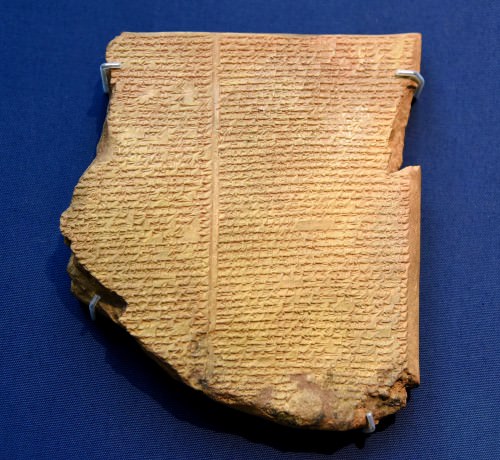
Flood Tablet of the Epic of Gilgamesh
Prior to this time, as noted, the Bible was considered the oldest book in the world, the Song of Solomon was thought to be the oldest love poem; but all of that changed with the discovery and decipherment of cuneiform. The oldest love poem in the world is now recognized as The Love Song of Shu-Sin dated to 2000 BCE, long before The Song of Solomon was written. These advances in understanding were all made by the 19th century CE archaeologists and scholars sent to Mesopotamia to substantiate biblical stories through physical evidence.
Along with other Assyriologists (among them, TG Pinches and Edwin Norris), Rawlinson spearheaded the development of Mesopotamian language studies, and his Cuneiform Inscriptions of Ancient Babylon and Assyria, along with his other works, became the standard reference on the subject following their publication in the 1860's CE and remain respected scholarly works into the modern day.
George Smith, regarded as an intellect of the first rank, died on a field expedition to Nineveh in 1876 CE at the age of 36. Smith, a self-taught translator of cuneiform, made his first contributions to deciphering the ancient writing in his early twenties, and his death at such a young age has long been regarded a significant loss to the advancement in translations of cuneiform in the 19th century CE.
The literature of Mesopotamia informed all the written works which came after. Mesopotamian motifs can be detected in the works of Egyptian, Greek, and Roman works and still resonate in the present day through the biblical narratives which they inform. When George Smith deciphered cuneiform he dramatically changed the way human beings would understand their history.
The accepted version of the creation of the world, original sin, and many of the other precepts by which people had been living their lives were all challenged by the revelation of Mesopotamian - largely Sumerian - literature. Since the discovery and decipherment of cuneiform, the history of civilization has never been the same.
LICENSE
Article based on information obtained from these sources:with permission from the Website Ancient History Encyclopedia
Content is available under License Creative Commons: Attribution-NonCommercial-ShareAlike 3.0 Unported. CC-BY-NC-SA License